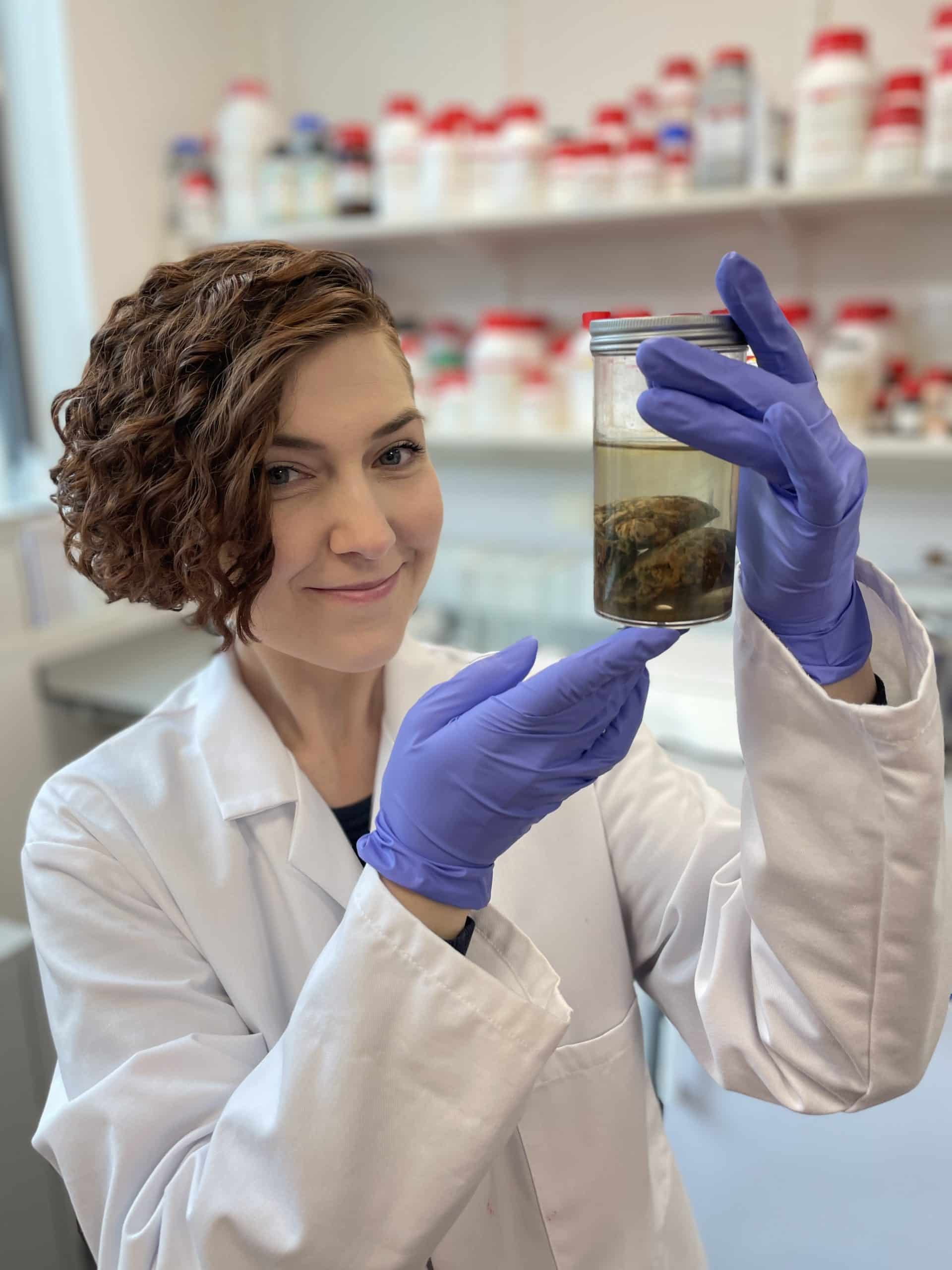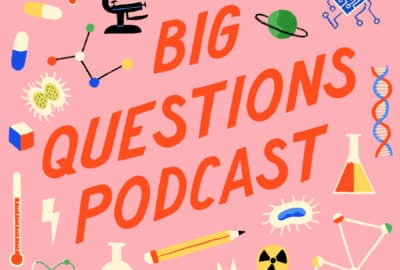How do you fossilise a brain?
Wednesday 5th Jun 2024, 12.30pm
When you think of fossils, you probably imagine dinosaurs. But did you know that soft body parts, like the brain, can become fossils too?
In this episode, forensic anthropologist Alexandra Morton-Hayward explores the science of brain fossilisation. Skeletons have been found in wells, Incan temples, salt mines and many other unusual locations, often with no other organs, hair or skin preserved. With only a brain nested in the skull, we are asking … how can this happen?
Listen now to find out and discover how this research is unravelling ancient human history!
Emily Elias: If you show me a picture of a fossil, I think I know what I’m looking at and how it’s made. But cards on the table, I have no idea, let alone how something soft and squishy like a brain would turn into one. But we’re gonna get the answers! On this episode of the Oxford Sparks Big Questions podcast, we’re asking, how do you fossilise a brain?
Hello, I’m Emily Elias, and this is the show where we seek out the brightest minds at the University of Oxford, and we ask them the big questions. And for this one, we have found a researcher who is really good at finding fossilised brains and taking very good care of them.
Ally Morton Haywood: My name is Ally Morton-Haywood and I’m a forensic anthropologist at the University of Oxford.
Emily: Okay, so forensic anthropologist, so you know how fossils are made. Because as much as I want to say, like, I’m smart and I know this, I don’t really know this.
Ally: Absolutely! It’s not a straightforward question – how does a fossil get made? When we think of fossils, first and foremost, we’re thinking of the preserved remains of the fossil organisms, so the ancient deceased plants or animals themselves that are preserved in the rock. And this is what we call a body fossil.
But, of course, there are other types of fossils, too, like moulds and casts. So, for example, the victims of the Vesuvius eruption who are trapped in ash. And then there are also trace fossils as well, the remains of footprints and burrows and other traces of ancient life. But the most common method of fossilisation that we tend to think of is this way in which we make body fossils, and that’s called permineralization.
Emily: So what’s that like? It’s like a mommy fossil and a daddy fossil love each other very much and they decide they’re gonna make a baby fossil.
Ally: You could think of it that way! The way I would explain it is when an organism is buried in sediments like sand or mud, the spaces within the remains which are left behind by decayed soft tissue, for example, they become filled with these mineral rich fluids that move through porous sediments. And eventually these minerals can entirely replace the organic material, and their remains are literally turned into stone or petrified. Petra is the Latin word for rock or a stone. And this process can occur in really small spaces, even within a cell wall. And so this can produce these incredibly detailed, beautiful fossils that are made from the mommy and the daddy.
Emily: So can anything that is like a soft tissue turn into a fossil? Cause I know you specialise in brains. Are there better soft tissues that fossilise than others?
Ally: Absolutely. So, permineralization that we just talked about relies on the soft tissue decaying. But this doesn’t always happen. If your body fossil is not perminimalized, turned into rock; not compressed, turned into carbon, and it’s not a mould or a cast, then it’s possible you have what we would broadly term organic preservation. And here we’re talking about preservation of the soft tissues, which we’d otherwise expect to decay quickly.
So organic preservation can take all sorts of different forms, and it’s much more poorly understood than permineralization. For example, on the one hand you can have the straightforward preservation of whole organisms in amber, which is simply a matter of forming this oxygen free environment that halts decomposition.
But what I’m really interested in is when you have the kind of more mysterious preservation of an organism’s constituent biomolecules, like proteins, lipids and DNA. And this can be different depending on the organ that’s involved.
So as you mentioned, I study brains, and brains, forensically, we know that this is one of the first organs to decompose post mortem. So, it’s super weird to find it preserved in the archaeological and fossil records, and we don’t really understand what is happening in the brain. For example, if you have a waterlogged environment with a clay or iron component in the soil, you are likely to find a skeleton with no other soft tissue. No skin, no hair, no liver, no pancreas, no lungs, nothing else, but just the brain rattling around in the skull. And that suggests that there is a mechanism of preservation that is unique to the brain and doesn’t occur in other organs. And so the purpose of my research is to try and figure out what that mechanism is.
Emily: Okay, so, Ally, like, where are these, like, brains actually found? Are they like, hanging out in somebody’s fridge in like a jar? Or are they like a palaeontologist is digging and then they come upon it in, like, in the field?
Ally: Yeah, absolutely. Great question. So I think I may be the only person in the world that has them in a jar. I study them day in and day out, and there are hundreds in my fridge here in Oxford.
These brains are found in all sorts of different burial environments. So they could be at the bottom of a well. We have 80 something prisoners from, like, 18th century France that were found at the bottom of a well. We also find a lot in churchyards and other kind of conventional cemetery burial sites. We find them on the top of volcanoes, like Incan sacrifice. They’re ancient mummies that conventionally, the Ancient Egyptians practised excerebration, which is the removal of the brain. In some situations, they didn’t do a great job and now we have them in our fridge.
So there are all sorts of different places, but they’re always found where the individual was buried. So it’s not like someone has dug them up and then preserved them or it was removed prior to burial, for example, these are all spontaneously preserved in the ground.
And they really, truly can be super ancient. So palaeontologists have found the preserved nervous systems of critters like ammonites and trilobites which is those things that are swimming about in the sea, if you think of an ancient sea. So these things are half a billion years old. So all over the world, as part of the research that I’m doing, I’ve been reaching out to individuals in museums and research institutions who have been excavating these brains, and I’m collecting them together here at Oxford so that we can begin to answer these questions about how they’re preserving when all other organs are perishing.
Emily: Wait, okay, so, like, you have… how many brains do you have in Oxford?
Ally: So we have, more than 570. No. Excuse me! We have more than 600. I collected 30 last week from Belgium. So we now have more than 600 here in the fridges at Oxford. They are in all sorts of ranges of preservation, so some are absolutely gorgeous. They look like a kind of a shrunken walnut in the palm of your hand.
They’re all shrunken to around a fifth of their natural size in life. And so they actually fit quite neatly in the fridges in all sorts of different containers. Some sites have just dozens and dozens of brains coming out of the ground and they don’t know exactly how to store them or where to put them, co they’ve been using things like Chinese takeaway containers or jam jars. And so they’re just crammed into our fridges, ready for study.
Emily: Oh my God. So you have, like, a brain library of fossils?
Ally: Absolutely. And I love… I know it’s a bit crazy, but I used to work as an undertaker, so I’m very familiar working with the dead. And just as I did when I was undertaking, I would talk to the deceased around me, kind of as a coping mechanism for myself, because it can be a little creepy when you’re working around the dead. So whenever I open the fridges, I chat to them and make sure that they’re comfortable and behaving themselves.
Emily: Do you have any wayward brains that are acting up or are they all chill?
Ally: I have one that is my favourite. He comes on the road with me if I ever go to talks or if I go to give a lecture somewhere else, or if I’m talking to kids about fossilisation. I call him Rusty because he’s this incredible bright orange red colour. And, so Rusty is like, he’s my go to. He’s my dude.
Emily: RIP rusty. Thank you for your service.
Ally: He is like a guide dog for explaining how brains can preserve. And there’s nothing like seeing that in the palm of someone’s hand. You know, it’s really hard to grasp, but these things, they look exactly like brains. If you think of an MRI in an episode of House or some other medical tv show, they look exactly like that, but they’re bright orange or black, they’re speckled with yellow. So there’s a lot of iron in these things. But other than that, and the fact that they’re smaller than you’d expect, they look exactly like brains.
Emily: So how do you go about then, like, actually analysing them to do all your research with?
Ally: We have this huge archive that’s currently untapped of ancient human brains. More than 4400 excavated since the mid 100S, but less than 1% have been investigated at the molecular level. So there is huge scope for exploration.
And one of the first things that I did in exploring these tissues is I tried to image them using MRI. So magnetic resonance imaging. And again, if you think about a medical show where they’re looking into the brain, they’re probably using MRI. It’s this incredible way to really zoom into a tissue and look at the white matter pathways that tell us about whether someone is left or right handed or what their childhood was like. This incredibly detailed information that you can get from an MRI, but not if you’ve essentially soaked a brain in iron for the last 300 years, because it’s a magnet. Right?
So I just essentially put a really rusty brain, and it was Rusty, actually, and I felt so small when the technician said to me “you’ve just handed me a magnet to put inside a giant magnet”. It was a complete disaster. We got no information. But fortunately, we’ve really thought through the approach that we’re using since, so we’re studying the iron itself and doing other kind of imaging techniques as well. But, yeah, MRI was not the best idea in retrospect.
Emily: What do you hope? What is the big thing mystery that you want to unlock as you do all this different brain analysis?
Ally: So the main question for me is how does the brain preserve on geological time scales, when forensically we know that it’s one of the first organs to decompose?
In fact, I mentioned that I used to be an undertaker. My experience undertaking is the brain just liquefies super quickly. But clearly this huge archive we’ve published about shows that the brain actually, it preserves relatively frequently in a range of different environments, and so “why?” is the question that I really want to answer. And I think once we’ve answered that, we can begin to do some of the really cool research and figure out what ancient brains can tell us about ancient life. So that’s the super exciting next step.
Emily: This podcast was brought to you by Oxford Sparks from the University of Oxford, with music by John Lyons and a special thanks to Ally Morton Hayward.
Tell us what you think about this podcast. We are on the internet at @OxfordSparks. Or you can go to our website oxfordsparks.ox.ac.uk. I’m Emily Elias. Bye for now.





